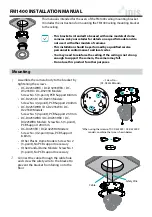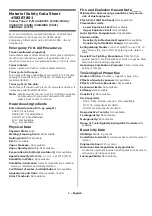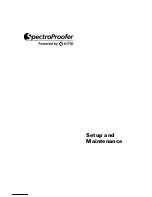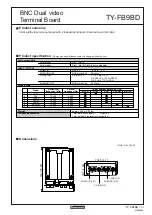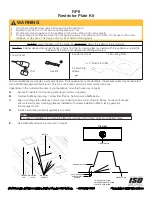
4
Pipe Extension Probe Mounting:
(See Figure 7)
1)
Select a mounting location in accordance with the Pre-
Installation Recommendations.
2)
If using a welded coupling, cut a hole into the top of the vessel
corresponding to O.D. of the 1-1/4” coupling used. If using a
Monitor mounting plate, cut a 2-1/2 inch (64 mm) center hole
and six 11/32 inch (9 mm) mounting holes (for 5/16” bolts)
on a 7 inch (178 mm) bolt circle. Use mounting plate
gasket as a template.
3)
Weld coupling or attach mounting plate to vessel wall.
4)
Insert probe through coupling, grease threads with anti-seize,
then, thread unit tightly into place by gripping and rotating
housing. Do not use sealant tapes (e.g. Teflon tape) or put-
ties. Continuity between sensor mounting point and vessel
wall must be maintained to assure proper probe operation.
5)
Mechanical reinforcement of the pipe extension should be
considered whenever the overall probe length (from mount-
ing point to probe tip) exceeds 60 inches (1.5 m).
Mechanical clamping, such as “U” or “C” channel with “U”
bolts should be used. DO NOT USE HEAT to connect brace
to pipe extensions as wiring inside pipe could be damaged.
Figure 7
Remote Electronics Mounting
The split architecture configuration is used to protect the elec-
tronics from excessive heat or physical vibration.
1)
Select a location that is within 12 feet (3.6m) wiring distance
of the remote probe but where the extreme temperatures or
vibration is not present.
2)
The Remote Electronics for Ordinary Locations has no holes
cut in the fiberglass box. Drill holes in enclosure insuring cir-
cuit separation between the remote probe interconnection
and the mains/outputs. Remove electronics (4 backpanel
screws) prior to drilling holes.
3)
The Remote Electronics for Hazardous Locations has three
conduit entrances, one of which is plugged at the factory.
This plug may be relocated as desired. All openings must
be suitably sealed to insure environmental and hazardous
location protections.
4)
Drill a hole pattern in the structure to which the Remote
Electronics will be mounted (See Mechanicals for details).
5)
Secure the enclosure to the structure using 1/4" (6mm) screws.
hazardous Location Precautions:
Observe the regulations listed in the National Electrical Code
regarding equipment in hazardous locations. In particular,
install a conduit seal fitting within 2 inches (50 mm) of the RF
Capacitance sensor (for Class I rated products only), ensure
power is disconnected whenever the cover is removed, upon
completion ensure cover is completed re-attached and termi-
nate IS ground screw to local intrinsically safe ground. Do not
substitute any electrical components as this may impair intrin-
sic safety and thereby compromise safety.
Factory wiring:
The MK-2 probe wires are connected to the backside of the
PCB. DO NOT alter this connection. Doing so will likely
cause improper operation of the sensor.
Permanently Connected Equipment:
Disconnecting devices shall be included in the system installation.
More on next page >
ELECTRICAL INSTALL ATION
Adding Solid Probe Extension - Optional:
(See Figure 7A)
If it is necessary to augment the length of the 16” (406mm)
standard sensing probe, probe extensions are available.
To attach the probe extension slip the coupling end of the
extension over the free end of the standard probe. Align the
through-holes in the coupling with the through-hole in the probe
and insert the supplied roll pin.
Figure 7A
SOLID PRObE
EXTENSIONS











